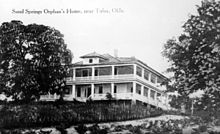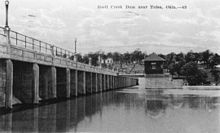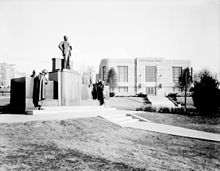- Charles Page
-
For other people named Charles Page, see Charles Page (disambiguation).
Charles Page Born Charles Page
June 2, 1860
Arnott, WisconsinDied December 27, 1926 (aged 66)
Sand Springs, OklahomaNationality United States Occupation Businessman Known for Founder of Sand Springs, Oklahoma Charles Page (June 2, 1860 – December 27, 1926) was an important philanthropist in the early history of Oklahoma and Tulsa. His enduring act was the creation of the Sand Springs Home for orphans and widows and otherwise unwanted and unloved children. Concurrently, he founded the city of Sand Springs, Oklahoma to support the home.
Contents
Early life
Page was born in Arnott, Wisconsin, outside of Stevens Point, Wisconsin to James William and Mary Gottrey Page. Charles dropped out of school in 1870 and began working on a freight wagon after his father became too ill to work. The father died when Charles was eleven years old. Thereafter, he took care of his mother and four younger siblings.[1][2]
For many years, Page's life consisted of a series of jobs in an attempt to support his family. In the early 1870s, he helped his mother cook for Wisconsin Central Railway workers. Additionally, he worked as a railway dispatcher and clerked in a general store. In 1876 - 1877, he worked as a lumberjack and logger. In 1879, he became a policeman in Ashland, Wisconsin. In the following two years, he became chief of police for Tower, Minnesota and then went to work for the Pinkerton Detective Agency.[1]
Charles married his first wife, Lucy, in Duluth, Minnesota in 1881. She already had a son named Willie, who Page adopted. The family moved to Ellensburg, Washington during the 1880s, where Charles became an agent for the Northern Pacific Railroad. Moving to Tacoma, Washington, Charles tried and failed as a hotel owner and as a commodities trader. From 1888 to 1890, he went to Canada searching for gold. During all this time he continued to send money to support his mother, until her death in 1891. During the 1890s, Charles worked in the mining industry in Washington, Idaho, Colorado and Canada. He apparently made some money, but lost all his savings in the Panic of 1893. In 1900, he moved to Colorado Springs, Colorado where he got into real estate development, oil well drilling, and investing in power plants.[1]
Move to Oklahoma
Charles, Lucy and their son moved to Oklahoma City, then in Oklahoma Territory in 1901. They lived there until 1903, when they moved to Tulsa, then a boom town in Indian Territory, where he bought a hotel and began an independent drilling operation. His initial wells were unsuccessful, but in 1905 his well named "The Taneha" began producing 2,000 barrels per day, helping Page make his first million dollars. Another of his wells hit natural gas in the Glenn Pool field. Sadly, Lucy Page died of cancer in 1906.[1]
Founding of Sand Springs
Charles had never forgotten how his mother had struggled in poverty to keep her family together after her husband had died. There were few resources in the 19th and early 20th century to help either widows or orphans. He knew first-hand how fatherless children often had to forgo a school education to help support themselves or their families by working full-time in menial jobs. Now that Charles had begun to prosper, he thought about how he could help others caught in the same situation. He envisioned creating a planned community where widows and orphans could live and become more productive members of society.
In 1908, Page purchased a quarter section of land to the west of Tulsa. Soon, he acquired other adjoining properties. On this land, he eventually founded a town that he named Sand Springs. He also used part of the land for the Sand Springs Home and helped establish various schools in West Tulsa, including Berryhill. He was also very generous with various charities in Tulsa including the Salvation Army, although he was not known to be affiliated with any particular church. Page quickly formed a friendship with the Tulsa Salvation Army captain, Brinton F. Breeding. He soon persuaded Breeding to work for him in developing the land for the envisioned orphanage.[1]
On July 22, 1909, Charles married his second wife, Lucile Rayburn, in Denver. They returned to Tulsa, where Page had built a house at Third Street and Olympia Avenue. In 1912, they adopted a baby girl named Mary Ann. In 1915, the family moved to a new home at 810 North Main in Sand Springs.[1]
Sand Springs Home and Widow's Colony
In May, 1909, Page rescued 21 orphans from a bankrupt orphanage in Tulsa, legally adopted them and put Breeding in charge of the home. Thereafter,Page referred to the orphans as his "kids" and they referred to him as "Daddy."[3]. Breeding would remain as superintendent until 1948.[1] The Sand Springs Home is actually two different things. It is the name of the organization Charles Page founded to care for orphans and widows after he died. It is also the name of the building he built to house his orphans. The main dormitory was built in 1918. In it the children had matrons assigned to them to watch after them. In the dining area each family of children had their own table so they could eat together. When Charles Page was still alive he often preferred to eat with his kids at their tables, rather than sit at the main table with the rest of the adults. In recent years the few children who still live at the home were moved into cottages that surround the old home dormitory, which was demolished in 2006 to make way for a new recreation center for the home.
In 1912, Page began the construction of a widows colony for widowed and divorced women with children to support. The colony consisted of forty three-room shotgun houses. As years passed and the old colony homes began to fall into disrepair they were replaced with new two-bedroom brick cottages. The colony grounds came complete with a chapel and a nursery. Each house was provided with free water, free gas, free electricity, free rent, and a quart of milk per child per day. In order for a woman and her family to live in the colony, she had to have at least one child still in school, including college, her children had to maintain a "C" average in school and they had to observe all the colony rules of behavior.
Shell Creek
Charles Page owned the Sand Springs Bottling Company, which was the dominant supplier of fresh water for domestic consumption. By 1920, he had built a dam on Shell Creek, which created Shell Lake, near Sand Springs, Oklahoma and proposed to sell fresh water to Tulsa. His proposal competed with the alternative of building a dam on Spavinaw Creek. Heated competition between the two major newspapers, Tulsa Democrat (owned by Page), which supported the Shell Creek proposal, and the Tulsa World (owned by Eugene Lorton), which supported the Spavinaw plan. Page's proposal was rejected when tests showed that the quantity was inadequate to meet Tulsa's expected needs.[4]
Industrial Development
Charles Page continually campaigned to attract companies to move to Sand Springs to provide jobs for his "kids". Of the many industries of early day Sand Springs, some examples include: Sheffield Steel, Kerr Glass Company, Southwestern porcelain, Commander Mills (a cotton mill) and Sinclair Prairie Refinery.[5]
Death and Memorials
Charles Page died of influenza on December 27, 1926,[1] but is still remembered in his community. The main street of Sand Springs is named "Charles Page Boulevard". This street connects Sand Springs to Tulsa, where it becomes West Third Street.
In the town's center there is a statue of him next to a library that is also named for him. The Sand Springs Home continues to help families and children today. Sand Springs' high school is named Charles Page High School in his honor. There is also a park named for him in Sand Springs.
Charles and Lucile Page are both entombed at Woodland Cemetery in Sand Springs. Their marble tomb and the library named after Charles were built at the same time at the direction of Lucile Page.
Later, the Page home at 810 North Main in Sand Springs was damaged by a fire. Lucile was still living there at the time but was uninjured. The fire was extinquished by the Volunteer Fire Department of Sand Springs.
References
- ^ a b c d e f g h Sand Springs Leader Website "Charles Page 150th birthday A timeline." June 3, 2010. Retrieved July 3, 2011. [1]
- ^ Encyclopedia of Oklahoma History and Culture: "Page, Charles E(dward?) (1860 - 1926)". Accessed July 3, 2011.[2]
- ^ New York Times, September 12, 1915. "Oklahoma Man Built a Town for Widows"
- ^ Davis, Kirby Lee. The Journal Record (Oklahoma City). "These Walls: Spavinaw watershed in Tulsa" July 24, 2009.[3]
- ^ Encyclopedia of Oklahoma History and Culture, "Sand Springs" Accessed May 6, 2011.[4]
- Clark, Opal. A Fool's Enterprise. Dexter Publishing Company: Sand Springs OK, 1992.
External links
- Horn, Nina A. (1987) 1987 Hall of Fame Inductee: Charles Page, Tulsa Historical Society.
- "Oklahoma Man Built a Town for Widows", New York Times, September 12, 1915.
Categories:- American philanthropists
- People from Portage County, Wisconsin
- People from Tulsa, Oklahoma
- People from Sand Springs, Oklahoma
- 1860 births
- 1926 deaths
Wikimedia Foundation. 2010.



